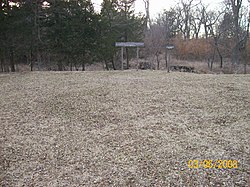Battle of Black Jack
| Battle of Black Jack | |||||||
|---|---|---|---|---|---|---|---|
| Part of Bleeding Kansas | |||||||
 A sign showing the surrender point of Henry Pate on the Black Jack Battle site. |
|||||||
|
|||||||
| Belligerents | |||||||
| Free-State Abolitionists | Slave State | ||||||
| Commanders and leaders | |||||||
| John Brown | Henry C. Pate | ||||||
| Strength | |||||||
| 30 | ~30 | ||||||
| Casualties and losses | |||||||
| unknown | 23 prisoners | ||||||
|
Black Jack Battlefield
|
|
| Location | Baldwin, Kansas |
|---|---|
| NRHP Reference # | 04000365 |
| Designated NHL | October 16, 2012 |
The Battle of Black Jack took place on June 2, 1856, when anti-slavery forces, led by the noted abolitionist John Brown, attacked the encampment of Henry C. Pate near Baldwin City, Kansas. The battle is cited as one incident of "Bleeding Kansas" and a contributing factor leading up to the American Civil War of 1861 to 1865.
In 1854, the U.S. Congress had passed the Kansas-Nebraska Act which stipulated that the residents of these territories would decide whether they wished to enter the Union as a slave or free state. This doctrine became known as popular sovereignty. Organized groups from the North sent thousands of abolitionist supporters to Kansas in an attempt to tip the balance in favor of free state advocates, to counter settlement from pro-slavery supporters from Missouri. As a result, pro- and anti-slavery groups had frequent clashes culminating in the Battle of Black Jack.
On May 21, 1856, Henry C. Pate participated with a posse of 750 pro-slavery forces in the sacking of Lawrence, which destroyed the Free State Hotel, two abolitionist newspaper offices and their printing presses. They also looted throughout the village. The next day, Congressman Preston Brooks from South Carolina physically attacked Senator Charles Sumner of Massachusetts in the Senate chambers with a cane. He continued hitting after the senator was bleeding and unconscious. After that, a band of men, led by John Brown and comrade Captain Shore, executed five proslavery men with broadswords at Pottawatomie Creek. Brown's men let Jerome Glanville and James Harris return home to the cabin of Harris. This incident became known as the Pottawatomie massacre. Following the massacre, three anti-slavery men were taken prisoner, including two of John Brown's sons.
...
Wikipedia


